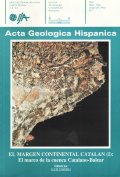Tesis doctoral: Estudio Gravimétrico del Pirineo Oriental
Abstract
This dissertation is primarily a gravimetric study of Eastern Pyrenees based on gravity prospecting techniques combined with seismic reflection profiles, magnetic survey, and the existing bore-holes. The two main objectives of the study are interpret the gravity anomalies produced by superficial bodies and the anomalies produced by deep bodies in the area lying between the Segre River to the West, the Mediterranean Sea to the East, the city of Manresa to the South, and the city of Perpinyi to the North.
The general disposition of these anomalies is composed of negative values in NW part of the studied zone and positive values along the coastline. This disposition is due to the enlarged upper crust under Pyrenean Axial Zone as a result of Iberian and European plates collision, and the thinning crust near the Coast To verify the existence of sorne of the anomalies, several macroscale maps of residual gravity anomalies of the area were compiled. The regional gravity component is assimilated to a second and third degree by polynomical surfaces. A residual isostatic map was also realised. Other smaller-scale maps were drawn up later because the use of lower-degree polynomes it is possible to obtain a more acceptable adjustment of regional-residual separation.
After calculating gravity models in several zones, it was concluded that negative gravity anomalies are produced by Neogene materials landing in the Empordh and Cerdanya grabens, detritic Eocene materials in the Rocacorba area, and marls accumulation resulting from duplex structures and halite diapires. Positive gravity anomalies are caused by Carnbro-Ordovician materials, anhydrites, and basic volcanic rocks.


